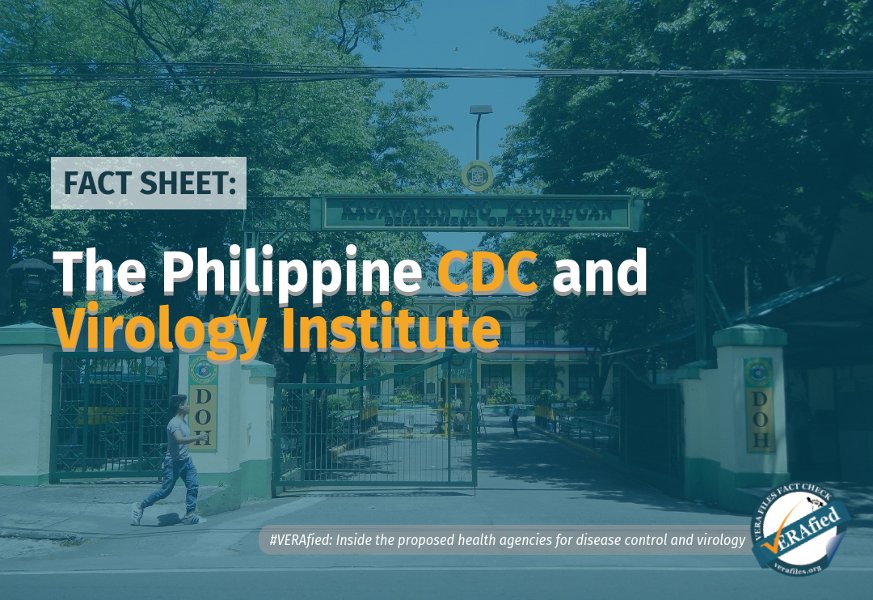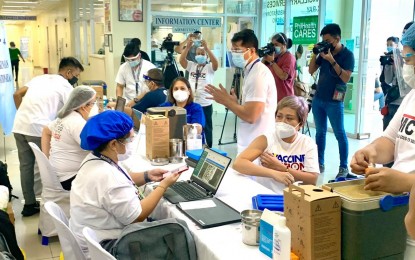Almost two years into the coronavirus disease 2019 (COVID-19) pandemic, variants of the novel coronavirus are getting “fitter and better” at transmission in humans, according to the World Health Organization (WHO).
“Outbreaks like this test the capacity of government and society as a whole to respond in ways that produce the most benefit and the least harm to the citizenry,” said Esperanza Cabral, former Secretary of Health, in an email to VERA Files Fact Check.
To boost the resilience of the Philippines in public health emergencies, President Rodrigo Duterte called on Congress to pass a law creating two new health agencies—one that monitors infectious diseases and another that focuses on studying viruses and viral diseases—during his final State of the Nation Address (SONA) on July 26.
Two days after the president’s request, the House of Representatives passed on third and final reading two measures to create the Philippine Center for Disease Prevention and Control (CDC) and the Virology and Vaccine Institute of the Philippines (VIP). The counterpart CDC and VIP bills in the Senate remain pending at the committee level.
What would the creation of these health agencies mean? Here are three things you need to know:
1. What will these health agencies look like?
The House-approved Philippine CDC will serve as the authority on forecasting, preventing, monitoring, and controlling diseases, injuries, and disabilities of local and global concern.
If enacted, Health undersecretary Rosario Singh-Vergeire said in an Aug. 11 media forum that the separate agencies in charge of the current pandemic response will be streamlined into the CDC.
Based on the House and Senate measures, the DOH units that may be transferred to the CDC include:
Similar to the House measure, the three Senate bills filed separately by senators Grace Poe (SB 1450), Richard Gordon (SB 1440), and Christopher “Bong” Go (SB 2158) all propose that the new CDC be attached to the Department of Health (DOH).
But Gordon has opposed the proposal to place the CDC under the DOH Office of the Secretary, saying it should be “independent” subject to “certain controls by the President or by an advisory board.”
“The reason why you have a Center for Disease Control is that you would want to be able to get doctors who are independent-minded, not to tip-toe their way into a political minefield,” he said during a Senate Committee on Health meeting in May.
Meanwhile, the VIP, as proposed by both houses, is intended to lead the research and development of vaccines and testing kits, as well as the diagnosis and treatment of viral diseases, under the Department of Science and Technology (DOST). Its facility is targeted to rise in New Clark City in Tarlac by 2023, according to DOST.
If established, Science and Technology Secretary Fortunato De la Peña said in an email to VERA Files Fact Check that the VIP will be a “key player” in doing research on viruses and viral diseases from humans, plants, and animals and vaccine development for the country.
Four Senate countermeasures of the VIP bill have been referred to the committees on Science and Technology, Health and Demography, Ways and Means, and Finance as of publishing.
2. How much will these cost?
Vergeire said the budget for the CDC is still being discussed, while DOST is asking Congress P2 billion as initial funding for the VIP, according to De la Peña.
In May, DOST announced the approval of six foundation studies worth P284 million to be implemented by its Industrial Technology Development Institute as part of the initial research for the proposed Virology Institute.
3. How does the creation of the two agencies affect the country’s pandemic response?
Amid limited supplies in the country, DOST said the VIP could make the Philippines “self-reliant and more pandemic-ready” with locally developed and cheaper technologies like vaccines, testing kits, and other treatments more accessible to Filipinos.
In an email to VERA Files Fact Check, Rowena Guevara, DOST undersecretary for research and development, said the country’s response to the COVID-19 pandemic “slowed down because we had to rely on the supply of test kits and vaccines from other countries that develops and manufactured them.”
Hence, one of the Institute’s first projects with the RITM would be the development of antibody test kits for COVID-19. This “responds to the country’s current need of around 90,000 tests daily” against the present capacity that “is only about half that much,” according to Dela Peña.
Another research project with the St. Luke’s Medical Center will look into antigenic peptides ー which are synthetically produced from proteins of the COVID-19 virus capable of immune response ー as potential vaccine candidates against COVID-19 and its variants.
The CDC, on the other hand, is expected to “modernize” the public health emergency preparedness and response capabilities of the country, based on the House measure.
Vergeire told reporters in a media forum that the CDC will “organize the national public health system” to make it “more prepared” in case another pandemic emerges in the coming years.
“This would improve our capacity as a country to respond to public health concerns through surveillance research, emergency response, and have a coordinative mechanism for local governments,” she said in a mix of English and Filipino.
As part of the modernization program, the House-approved bill also plans to establish counterparts of the CDC in all regions that will implement policies, provide emergency response, and conduct public health-related research, among other functions.
Former Health secretary Cabral, however, sees “many foreseeable challenges,” particularly in the implementation of the CDC. Among these are getting the funds to start and sustain the center’s infrastructure and operations, the need for trained personnel and continued capacity-building for them, and “freedom from bad political interference.”
As to its urgency, Cabral said “it is urgent enough, but there are many other urgent things we need to do to improve our response to pandemics in particular and the health care system in general.”
Locally, the tally of COVID-19 infections has reached 1.89 million Filipinos, with 131,921 active cases and 32,728 deaths as of Aug. 26.
Sources
Department of Health, Beat COVID-19 Media Forum, Aug. 11, 2021
Department of Health, Beat COVID-19 Media Forum, Aug. 13, 2021
Philippine Center for Disease Control
- House of Representatives, House Bill No. 9560
- Senate of the Philippines, Senate Bills No. 1440, 1450, 1445, 2158
- Senate of the Philippines, Public Hearing of the Committee on Health and Demography joint with Committee on Finance, May 6, 2021
Virology Institute of the Philippines
- House of Representatives, House Bills No. 6913, 9559
- Senate of the Philippines, Senate Bills No. 1543, 2241, 2155, 6913
- Philippine News Agency, Palace views creation of virology institute as ‘long-term’ plan, Aug. 14 2020
- Department of Science and Technology, DOST gets 284 M funding for Virology Institute in 2021, Nov. 4, 2020
- Senate of the Philippines, Bill establishing the Virology Science and Technology Institute of the Philippines filed by Bong Go to make Phl more prepared to face future health crises, May 6, 2021
- ABS-CBN News, Virology Institute of the Philippines to rise in Tarlac in 2 years: DOST, May 25, 2021
- Inquirer.net, PH’s Virology Institute to rise in end-2023 or in 2024 — DOST, May 25, 2021
- ABS-CBN News, Vaccine self-reliant PH? DOST says jabs may be manufactured in country by 2022, April 17, 2021
(Guided by the code of principles of the International Fact-Checking Network at Poynter, VERA Files tracks the false claims, flip-flops, misleading statements of public officials and figures, and debunks them with factual evidence. Find out more about this initiative and our methodology.)





